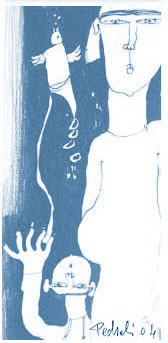The involvement of the interstitial Cajal cells and the enteric nervous system in bowel endometriosis cles
| The involvement of the interstitial Cajal cells and the enteric nervous system in bowel endometriosis Remorgida V, Ragni N, Ferrero S, Anserini P, Torelli P, Fulcheri E. Hum Reprod. 2005 Jan;20(1):264-271. 2004. |
|
Background: Our aim was to investigate the relationships between gastrointestinal symptoms and histological findings in women with bowel endometriosis. Methods: The gastrointestinal symptoms of 362 women with endometriosis were classified according to the subgroups of the Rome II criteria. All visible endometriotic lesions of the bowel were removed; the patients were prospectively followed up for 2 years. The interstitial Cajal cells (ICC) and the enteric nervous system were immunohistochemically evaluated. Results: Sixty-eight (18.8%, 95% CI 14.9-23.2) women had bowel lesions. The endometriotic lesions infiltrated the serosal layer and surrounding connective tissue in 45 cases; the subserous plexus in 11 cases; the Auerbach plexus in eight cases; the Meissner plexus in four cases. Whenever the subserous plexus was interrupted by the endometriotic lesions, the ICC were damaged. All women with endometriotic lesions reaching at least the subserous plexus reported bowel complaints. The level of infiltration into the bowel wall was correlated with severity of symptoms. Removal of lesions resulted in improvement of symptoms. Conclusions: Endometriosis-induced damage of ICC, even before muscular infiltration, may cause bowel symptoms. |
|

